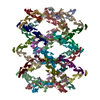+Search query
-Structure paper
| Title | The self-association equilibrium of DNAJA2 regulates its interaction with unfolded substrate proteins and with Hsc70. |
|---|---|
| Journal, issue, pages | Nat Commun, Vol. 14, Issue 1, Page 5436, Year 2023 |
| Publish date | Sep 5, 2023 |
 Authors Authors | Lorea Velasco-Carneros / Jorge Cuéllar / Leire Dublang / César Santiago / Jean-Didier Maréchal / Jaime Martín-Benito / Moisés Maestro / José Ángel Fernández-Higuero / Natalia Orozco / Fernando Moro / José María Valpuesta / Arturo Muga /  |
| PubMed Abstract | J-domain proteins tune the specificity of Hsp70s, engaging them in precise functions. Despite their essential role, the structure and function of many J-domain proteins remain largely unknown. We ...J-domain proteins tune the specificity of Hsp70s, engaging them in precise functions. Despite their essential role, the structure and function of many J-domain proteins remain largely unknown. We explore human DNAJA2, finding that it reversibly forms highly-ordered, tubular structures that can be dissociated by Hsc70, the constitutively expressed Hsp70 isoform. Cryoelectron microscopy and mutational studies reveal that different domains are involved in self-association. Oligomer dissociation into dimers potentiates its interaction with unfolded client proteins. The J-domains are accessible to Hsc70 within the tubular structure. They allow binding of closely spaced Hsc70 molecules that could be transferred to the unfolded substrate for its cooperative remodelling, explaining the efficient recovery of DNAJA2-bound clients. The disordered C-terminal domain, comprising the last 52 residues, regulates its holding activity and productive interaction with Hsc70. These in vitro findings suggest that the association equilibrium of DNAJA2 could regulate its interaction with client proteins and Hsc70. |
 External links External links |  Nat Commun / Nat Commun /  PubMed:37670029 / PubMed:37670029 /  PubMed Central PubMed Central |
| Methods | EM (single particle) |
| Resolution | 6.9 - 12.7 Å |
| Structure data |  EMDB-14706: 3D reconstruction of the cylindrical assembly of DnaJA2 delta G/F without symmetry imposition  EMDB-14727: 3D reconstruction of the cylindrical assembly of DnaJA2 by imposing D5 symmetry  EMDB-14729: 3D reconstruction of the cylindrical assembly of DnaJA2 without symmetry imposition EMDB-14736, PDB-7zhs: |
| Chemicals |  ChemComp-ZN: |
| Source |
|
 Keywords Keywords |  CHAPERONE / CHAPERONE /  oligomer / oligomer /  filaments / filaments /  helix / helix /  holdase / holdase /  foldase / foldase /  Hsp40 / DnaJA2 / Hsp70 co-chaperone Hsp40 / DnaJA2 / Hsp70 co-chaperone |
 Movie
Movie Controller
Controller Structure viewers
Structure viewers About Yorodumi Papers
About Yorodumi Papers







